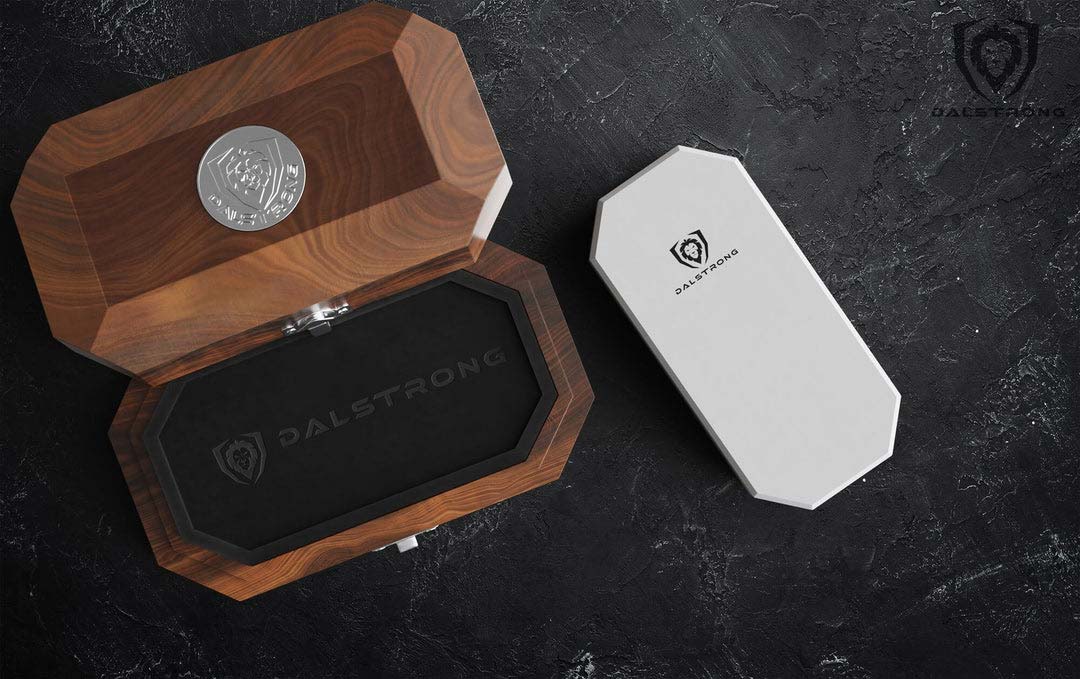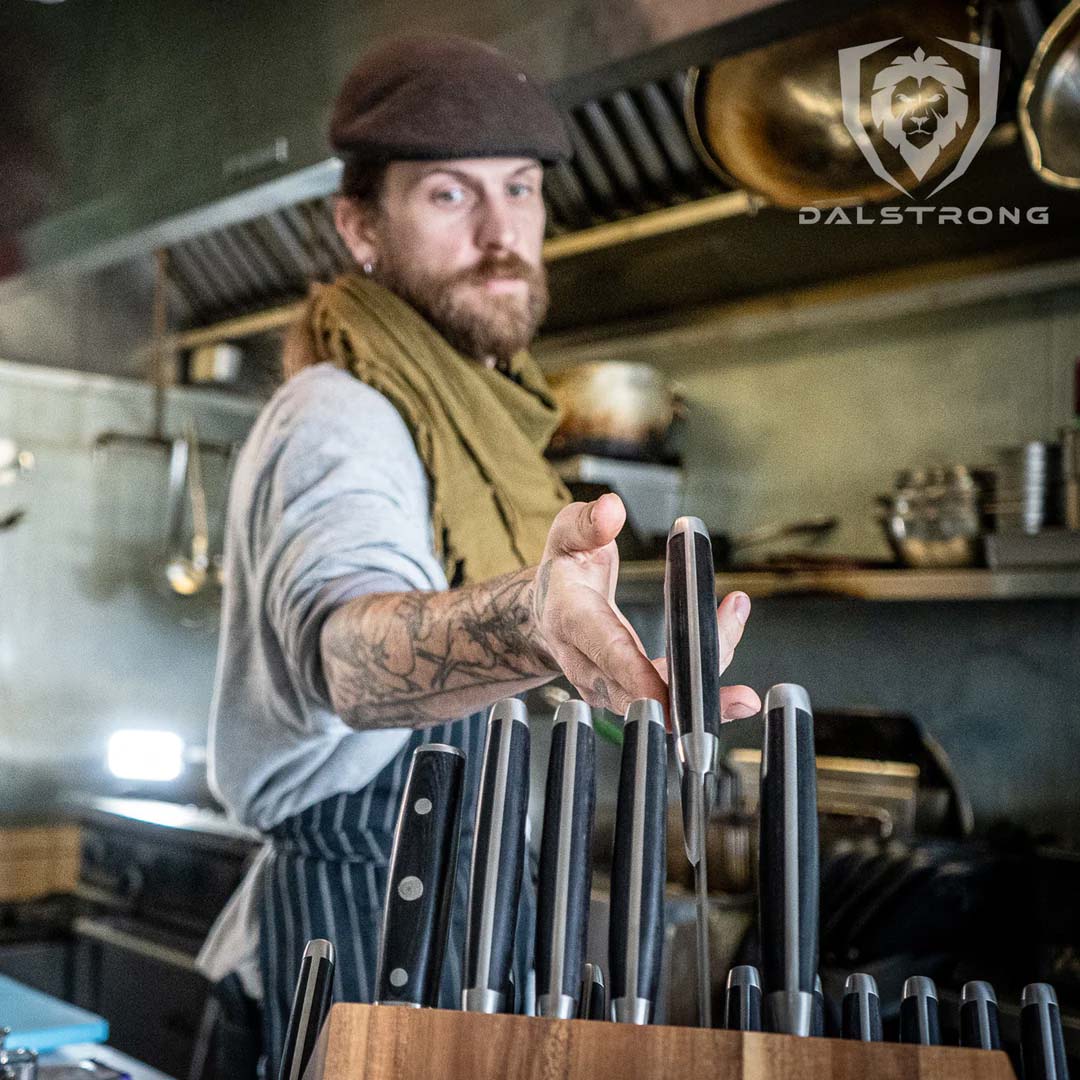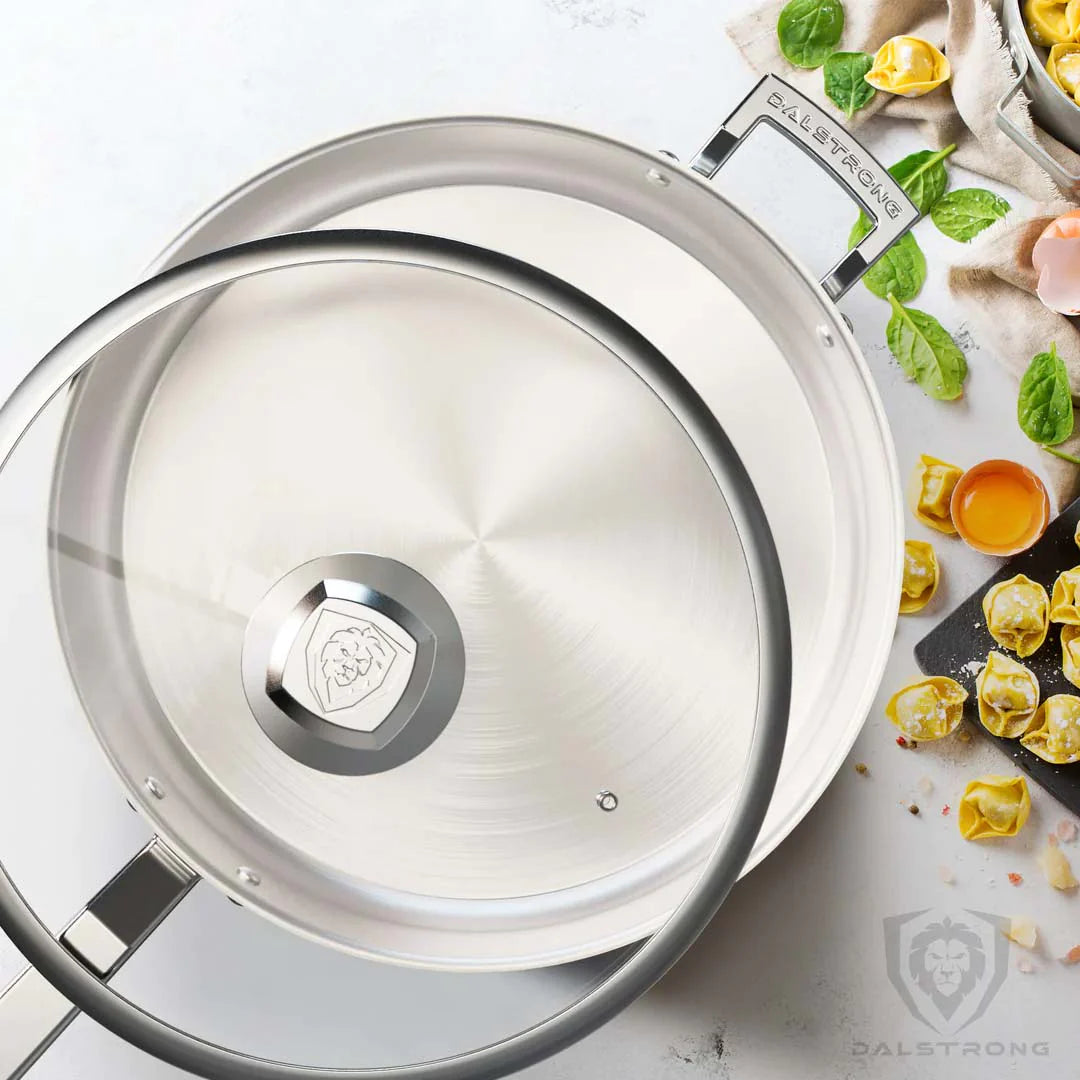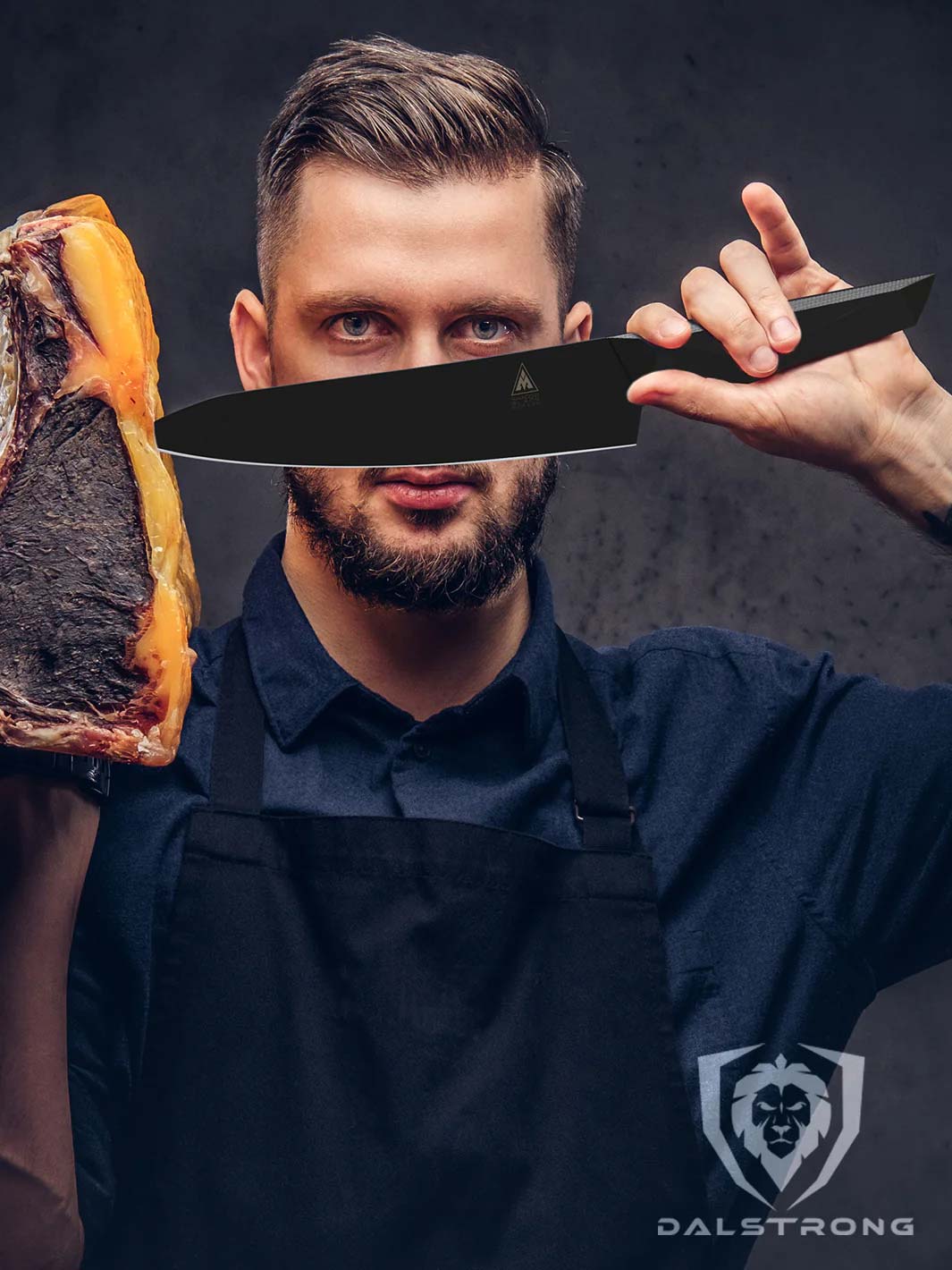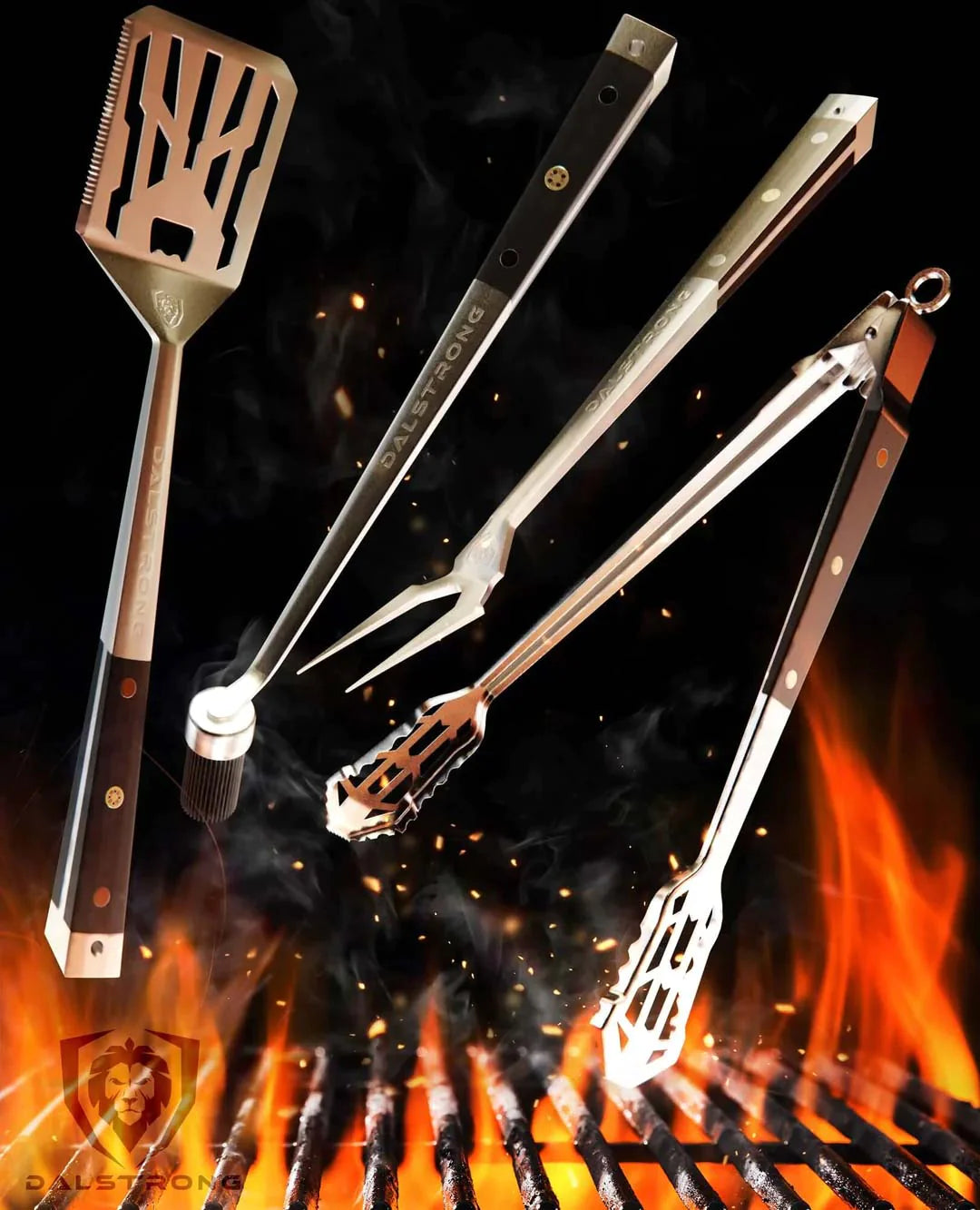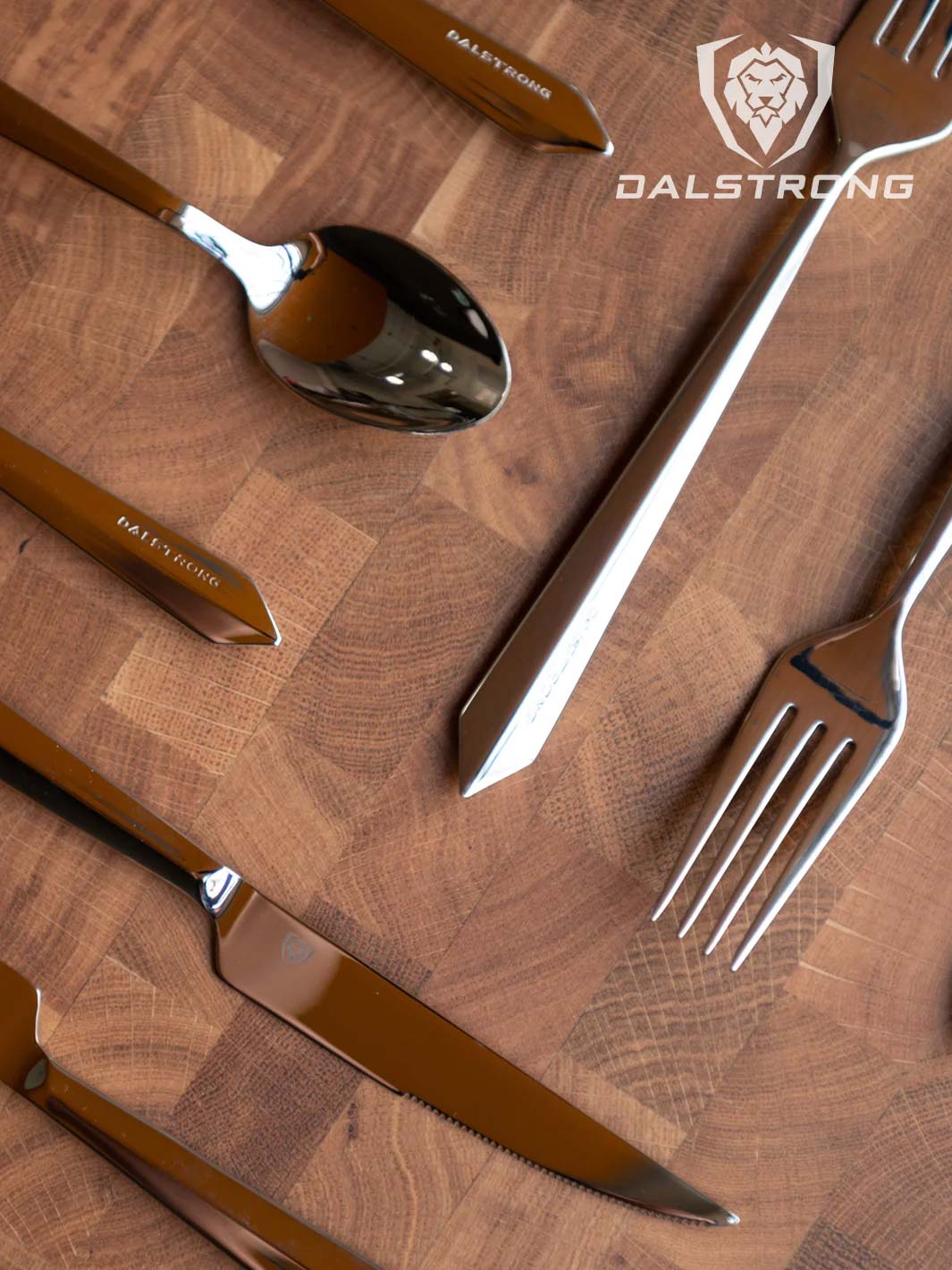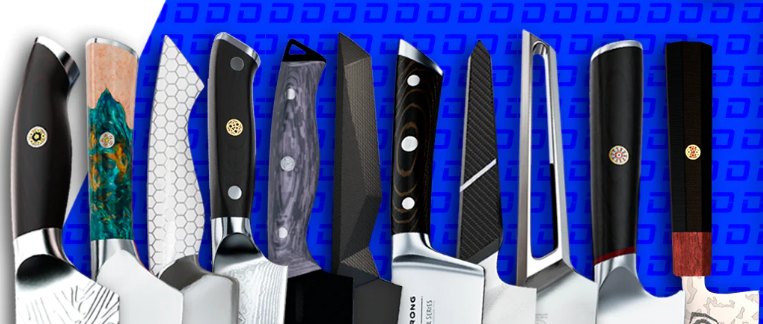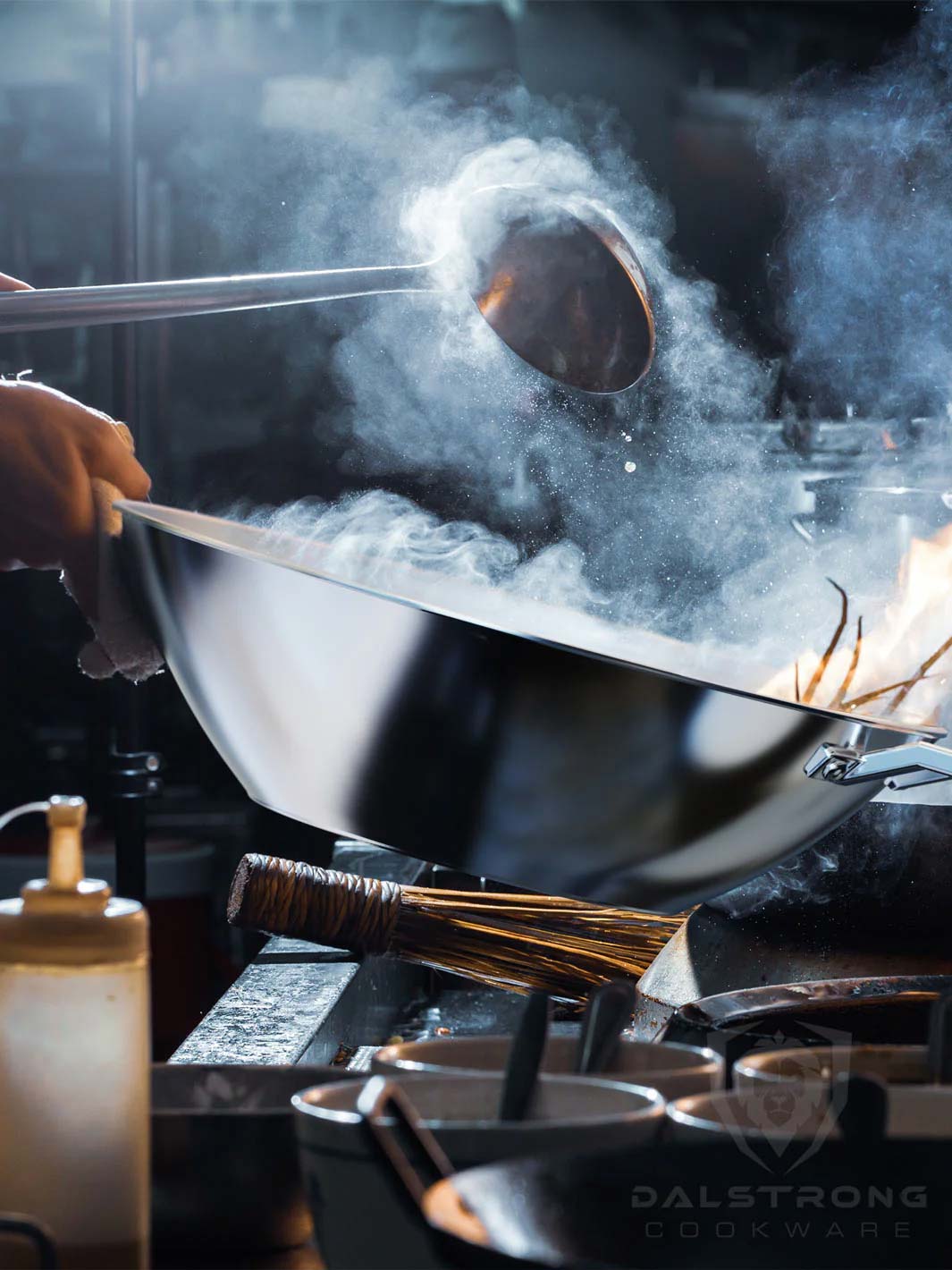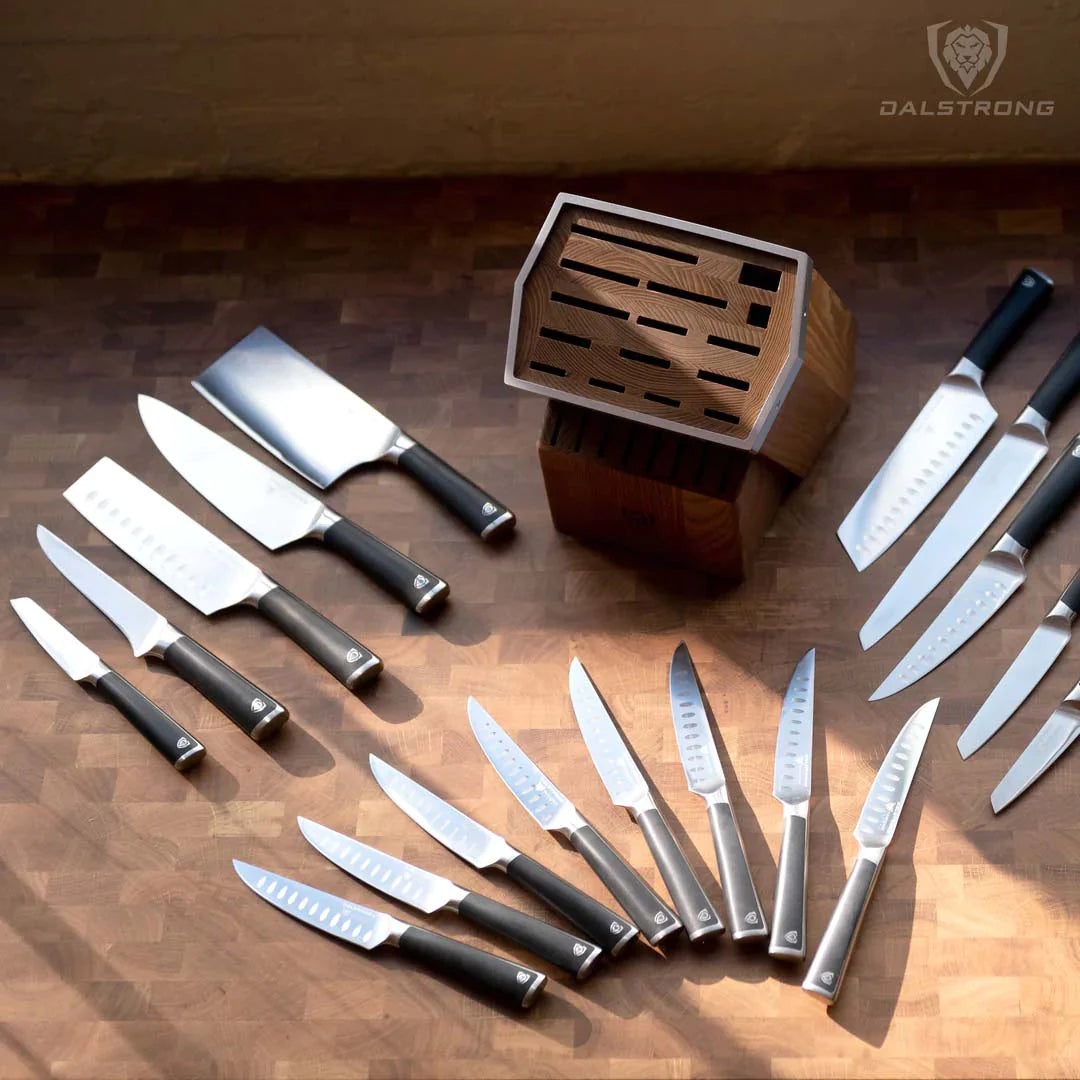Best Fillet Knife
BEST FILLET KNIFE
- Crusader Series 6.5" Fillet Knife
- Phantom Series 6" Boning Knife
- Shadow Black Series - 6" Filet Knife
- Quantum 1 Series 6" Fillet Knife
- The Frost Fire Series 6" Filet Knife
- Shogun Series 6" Filet Knife
- Omega Series 6" Curved Boning & Filet Knife
We’ve all been there, attempting to skin a large fish with a chef knife, or even a regular kitchen knife, leaving a full-on carnage on our cutting board. Sure, most folks will agree that filleting is a task that requires a dash of finesse but in truth, it’s really simple when you have the right tools at hand. Enter the fillet knife.
Whether you’re a seasoned outdoorsman or a savvy home chef, a fillet knife, also known as a filleting knife, is a must-have for anyone who enjoys fishing for food or simply cooking meat at home. With its strong yet lightweight blade, the fillet knife is perfect for separating the flesh from the bone, making sure no meat goes to waste. And while most people will use it to remove bones, scales, and skin from fish, some fillet knives will allow you to effortlessly bone poultry, wild game, beef, and even delicately peel fruit.
If you’re new to the world of fillet knives, then you’re in for a treat. Come with us on this marvellous trip through the subtleties and nuances of one of the handiest knives ever invented.
1. What To Look For In A Fillet Knife
Valhalla Series Fillet Knife 6.5"
When purchasing a fillet knife, you want to invest in a durable quality knife that will last a long time and be your ally in the kitchen as well as on your outdoor adventures. Cheap knives usually lose their edge pretty quick and no amount of sharpening will be able to bring them back to life, resulting in early disposal.
That said, if we’re getting into the minutiae of fillet knives, there are a couple of factors to be taken into account before making your purchase:
BLADE RETENTION
It is imperative that you get a fish fillet knife with excellent blade retention so it stays sharp for longer periods of time. A blunt blade will not only not do the job but it could also expose you to kitchen accidents, compromising both your integrity and the success of the food prepping process. However, even the most trustworthy knives will need a sharpening from time to time.
Regardless of your sharpening method of choice (whetstone, sharpening steel, electric knife sharpener, etc.), make sure you check out our tutorial on how to sharpen a knife here to keep your fillet blade’s sharp edge.
MATERIAL
Your fillet knife’s material is also very important. Since fillet knives are most frequently in contact with wet materials, we strongly suggest you get a stainless steel knife with added chromium to prevent corrosion and extend your fillet knife’s lifespan. A corrosion-resistant, stainless steel blade is a must.
THICKNESS
Fillet knives should be flexible in order to easily maneuver around bone, muscle, and connective tissue. The general rule of thumb is, the thinner the blade, the more flexible it is, allowing you to work the contour of the fish with laser-sharp precision. In terms of thickness, a fillet knife should be 2.5-3.5mm at the spine (or less). So yes, a thin blade will get you places.
HANDLE
The handle of a fillet knife can come in several shapes and forms, with materials ranging from wood to plastic and rubber. Like we mentioned in point 2, the humidity of the materials you’re working with is a key factor and you should always look out for a handle that’s both ergonomic and corrosion-resistant, guaranteeing a tight grip and optimal durability.
MAINTENANCE
Make sure you clean your fillet knife blade after every use and store it in a dry place. It’s also important that you only use your fillet knife for filleting - an irresponsible use of the knife could eventually result in a blunt blade, much to your dismay.
TYPE
There are basically two types of fillet knives: manual or electric. Both will do the job just as well but electric fillet knives tend to be larger, heavier, and more expensive. Also, an electric fillet knife requires a power source, either from a rechargeable battery or a plug-in, and that can become a problem when you’re fishing or hunting outdoors so a fixed blade is clearly the optimal choice. For this reason, we suggest you try to stick to manual fillet knives as they are more portable, lightweight, and generally cheaper. A folding fillet knife is a great example of this type of fishing knife.
SHEATH
The sheath is also an important part, as it plays an essential role in the conservation of your fillet knife. There are a wide variety of materials available, such as leather, nylon, and plastic. Yes, a leather sheath definitely looks cooler than the other options but it can soak up moisture and end up reducing your fillet knife’s lifespan. Our recommendation is a quick-drying plastic sheath that has plenty of ventilation and room for draining.
Note: When using your fillet knife in the kitchen, it is of absolute importance that you not only master the proper technique but you also look cool while doing it. But don’t worry, we’ve got you covered. Check out some of our fashionable aprons right here.
Learn more about where Dalstrong Knives are manufactured here!
2. Best Fillet Knives
If you’re an experienced fisherman, you might’ve heard about the ubiquitous Bubba Blade, Rapala, and other brands specialized in outdoor activities. And while the kitchen is our forte, Dalstrong fillet knives can be excellent companions when venturing into the wild. Fish filleting is an art, let's meet your brushes.
1. Crusader Series 6.5" Fillet Knife ($69.99)
Built from a single piece of German-made ThyssenKrupp stainless steel, the Crusader fillet knife is the stuff professional chefs dream of. But don’t be fooled by its intimidating appearance - its full tang blade, painstakingly sharpened at 16-18 degrees per side, will become a trusted ally in your kitchen as you make your way from amateur cook to filleting savant.
Pros:
- Incredible piece of artisanship.
- Extremely hygienic.
- Fuller groove near the spine helps reduce drag.
- Cleans easily.
Cons:
- Its unique looks might not be for everyone.
- Some people prefer a traditional wooden handle.
2. Shadow Black Series - 6" Filet Knife ($59.99)
With its striking, pitch-black titanium coating, the Shadow Black Series fillet knife will surely turn heads in both your kitchen and on your weekend fishing trips. A ruthless performer, this 6” fillet knife is not only a looker but an all-around workhorse that will excel at boning just any type of meat.
Pros:
- State-of-the-art design.
- High carbon stainless steel blade at 58+ Rockwell.
- Unique geometric handle inspired by the F-117 Nighthawk Stealth Fighter.
Cons:
- Its avant-garde design might not be to everyone’s liking.
- This steel is a little more difficult to sharpen.
3. Phantom Series 6" Boning Knife ($79.99)
The Phantom Series 6.5” Fillet & Boning Knife is the essential tool for boning beef, pork, fish and wild game. The knife’s curved, narrow and ultra-sharp blade gets in close to the bone and in between joints and skin with ease, while the hollow divots ensure minimal drag and reduced friction. Featuring Japanese AUS-8 steel beautifully engraved with the Dalstrong name down the spine as well as the Japanese kanji for ‘phantom’ or ‘ghost’.
Each blade is painstakingly hand sharpened using the traditional Honbazuke method, bringing the edge to a razor sharp 13-15 degrees, ensuring swift, effortless cuts. A premium-quality polymer Dalstrong Saya (sheath) is included.
Pros:
- 6.5” precision forged blade with premium Japanese AUS-8 at 58 HRC.
- Curved blade allows knife to easily glide along the contours of bone.
- Beautiful hand polished satin finish blade, further refined with detailed engravings.
Cons:
- Some people prefer a thinner blade.
- Not as flashy as some of our other designs.
4. The Frost Fire Series 6" Filet Knife ($79.99)
Part of Dalstrong’s The Frost Fire Series, this astounding fillet knife just looks and feels right. From the 7-layer high-carbon, high-chromium 10CR15MOV steel blade to the premium quality white resin handle and its gorgeous honeycomb pattern, it is an excellent choice for someone looking for both incredible aesthetics and peerless performance.
Pros:
- The sandblast finish provides a cool “frosted” look and enhances non-stick properties.
- Painstakingly sharpened using the ancient 3-step Honbazuke method.
- Full tang handle for better grip.
Cons:
- Its unique design might be a little too out there for someone who prefers the look of more traditional knives.
5. Shogun Series 6" Filet Knife ($99.47)
Inspired by the meticulous design of Japanese knives, the Shogun Series 6” Filet Knife strikes the perfect balance between flexibility and strength. Its Japanese high-carbon AUS-10V steel blade narrow blade curves toward the pointed tip, facilitating a smooth separation of the meat from bone and skin with practically no effort. Besides its exceptional functionality, the Shogun is also a sight to behold - featuring Dalstrong’s Tsunami Rose pattern, this knife will make you swoon every time you take it out of its sheath.
Pros:
- 2.00mm thickness for added flexibility.
- 62+ Rockwell hardness for unparalleled edge retention.
- Beautiful copper mosaic pin on the handle for extra sophistication.
Cons:
- Its price point might be a little high for someone on a budget.
- Some people prefer a clean stainless steel finish as opposed to Damascus.
6. Omega Series 6" Curved Boning & Filet Knife ($99.99)
We end this list with a versatile all-terrain performer. Like its name indicates, The Omega Series 6" Curved Boning & Filet Knife is the only tool you’ll ever need for your boning and filleting activities. The American-forged BD1N-VX hyper steel blade easily glides between fat, muscle, and sinew with utmost delicacy and will work perfectly with tougher cuts of meat like pork, beef, or wild game.
Pros:
- The “LiquidMetal” pattern on the blade looks awesome and also minimizes drag.
- Corrosion resistant.
- Military grade G10 impervious to heat, cold, and moisture.
Cons:
- Some professional chefs might prefer separate knives for boning and filleting.
- Some people prefer a more traditional blade to the "LiquidMetal".
3. What Is A Fillet Knife Used For?
Frost Fire Series Fillet Knife 6"
The main goal of using a fillet knife is to obtain precisely cut pieces of boneless meat, also known as fillets, from a big fish or chicken. For this purpose, the fillet knife features a highly-flexible trailing point blade that curves upwards from the handle to the tip, making it easier to produce smooth, precise cuts.
This flexibility is what allows the knife to cleanly separate the meat from skin, bone, and sinew, leaving you with a set of lean fillets ready to be thrown to the grill.
4. What Is The Difference Between A Fillet Knife And A Boning Knife?
While they overlap on certain tasks, the fillet knife and the boning knife are two entirely different beasts.
The boning knife, as you might have guessed, is generally used to remove the bones from meat and fish. Despite possessing a certain degree of flexibility, they’re usually stiffer than fillet knives. With a blade length ranging between 5 and 7 inches, boning knives are also thicker and can easily debone a wide array of meats.
On the other hand, the purpose of the fillet knife is a bit more specific. Specially conceived to work with more delicate meats, their sharp blade generally falls somewhere between 5 and 9 inches and it’s way thinner and more flexible than other knives, making it the perfect tool to descale, de-skin, and de-bone smaller fish in a matter of minutes.
5. What Kind Of Knife Do You Use To Cut Fish?
Valhalla Series Fillet Knife 7"
I’m gonna mention the obvious here but when cutting and prepping fish, you want to make sure none of the bones get into the final product. That could end up costing you or one of your guests a trip to the ER. That’s why you should always use a fillet knife as the starting point of your fish cooking process.
If you’re into sushi, there’s also a whole host of Japanese knives you can check out, including the Yanagiba, which is a staple of Japanese cuisine and is commonly used to prepare sushi and sashimi.
6. Best Fillet Knife On A Budget
Delta Wolf Series Fillet Knife 6"
We’ve already established the importance of investing in a quality fillet knife, for both durability and performance. If you’re a little tight on money but still want to get a A-grade fillet knife to add to your collection, we strongly suggest the Gladiator Series 6" Curved Fillet Knife.
Gladiator Series 6" Curved Fillet Knife ($59.99)
The Gladiator fillet knife is a lean, mean, filleting machine. Its 2.0mm German ThyssenKrupp Steel curved blade will allow you to de-bone, de-scale, trim, and butterfly with surgical precision. On top of that, the rock-hollow divots help reduce drag, ensuring a cleaner, more efficient process. Without a doubt, this is an excellent knife through-and-through.
Pros:
- Tall blade provides better knuckle clearance.
- Added chromium for stain resistance.
- Military grade G10 ergonomic handle impervious to heat, cold and moisture.
Cons:
- The 6” blade might be a little small for people with bigger hands.
- Some people prefer a flashier design.
7. The Fishmonger & The Sea - A Dalstrong Film
SHOP DALSTRONG FILLET KNIVES TODAY
70 Day Money Back Guarantee with ALL Dalstrong Knives.
You can also check in with our Expert Knife Finder Quiz and get specific recommendations based on your needs.
Written by Pablo PerezWhen he's not adding way too much butter to his recipes, Pablo likes to write about knives, music, food, cinema, and all of the other things that make life worth living.





















































































































































































































